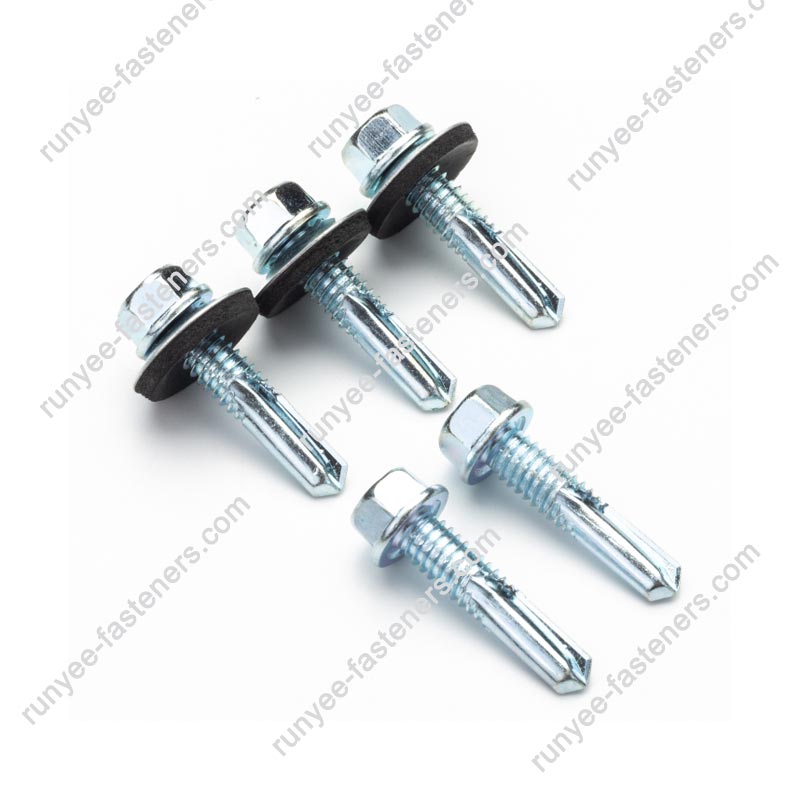What Makes Roofing Screws the Smart Choice for Long-Lasting Roof Performance?
2025-10-29
Roofing screws are specialized fasteners designed to secure metal roofing sheets, panels, or tiles to a variety of substrates such as steel, wood, or aluminum frames. Unlike standard screws, roofing screws are engineered with weather-resistant coatings, self-drilling points, and tight-sealing washers that prevent water infiltration, ensuring long-term roof durability. In modern construction, these screws play an indispensable role in protecting both residential and industrial structures from corrosion, vibration, and extreme weather conditions.
But what exactly sets roofing screws apart from regular fasteners? The answer lies in their precision engineering, protective coatings, and structural performance. As roofing systems evolve to meet higher standards of energy efficiency and sustainability, the use of high-performance roofing screws has become a defining factor in overall roof longevity.
Today’s roofing screws are not just about fastening; they are about securing reliability and structural integrity for decades. Their role in modern construction can no longer be overlooked, especially as more builders, architects, and homeowners seek sustainable, cost-effective, and high-strength solutions.
Below is a detailed overview of key parameters that define professional-grade roofing screws:
| Parameter | Specification / Description |
|---|---|
| Material | Carbon Steel, Stainless Steel, or Zinc-Plated Steel |
| Head Type | Hex Washer Head, Pan Head, or Countersunk Head |
| Thread Type | Self-Drilling, Self-Tapping, or Fine Thread |
| Washer Type | EPDM Bonded Washer for Leak Prevention |
| Coating / Finish | Zinc-Plated, Galvanized, Ruspert, or Dacromet Finish |
| Size Range | 4.8mm–6.3mm Diameter; Length 19mm–150mm |
| Drive Type | Hex Socket or Phillips Drive |
| Corrosion Resistance Level | Up to 1000 Hours in Salt Spray Test (ASTM B117) |
| Recommended Applications | Metal Roofing, Cladding, Timber Framing, Agricultural Structures |
| Certifications | ISO9001, CE, SGS, and RoHS |
These technical attributes highlight why roofing screws have become the preferred fastening solution for roof construction across diverse environments—from coastal buildings to high-humidity regions.
Why Roofing Screws Are the Future of Secure Roofing Systems
The growing emphasis on sustainable construction has redefined what builders expect from fastening systems. Roofing screws are evolving to meet these expectations by offering superior performance, longevity, and energy efficiency benefits.
a. Corrosion Resistance and Longevity
One of the biggest advantages of using roofing screws lies in their resistance to corrosion. Thanks to advanced coatings such as Ruspert or Dacromet, these screws can withstand harsh outdoor conditions, UV radiation, and chemical exposure. This results in fewer maintenance requirements and a longer life span for the entire roof structure.
b. Enhanced Sealing and Leak Prevention
Every roofing screw is typically equipped with an EPDM washer, which compresses upon tightening to form a watertight seal. This prevents water penetration through the screw holes—a common source of roof leaks in poorly installed systems. The elasticity of EPDM ensures consistent sealing performance even after years of thermal expansion and contraction.
c. Structural Integrity and Safety
In areas prone to strong winds, hurricanes, or heavy rainfall, roofing screws play a critical role in maintaining structural stability. Their self-drilling points and deep threads create a secure grip into metal or timber substrates, ensuring that roof panels remain firmly attached even under dynamic loads.
d. Cost Efficiency Over Time
While high-quality roofing screws may initially appear more expensive than standard fasteners, their long-term benefits—such as reduced repair costs, extended service life, and improved roof insulation—make them a cost-effective investment.
e. Environmental Compatibility
Modern roofing screws are often made using eco-friendly manufacturing processes, minimizing environmental impact. Stainless steel and recyclable zinc coatings align with the growing global demand for sustainable construction materials.
Future Trends in Roofing Screws:
The roofing industry is moving toward smarter fasteners—products that integrate advanced materials, nanocoatings, and even digital traceability. The focus is on creating screws that not only fasten but also monitor stress and corrosion levels through embedded sensors. Additionally, as roofing designs incorporate solar panel integration, new screw types are being developed to provide grounding compatibility and enhanced electrical insulation.
How to Choose the Right Roofing Screws for Different Applications
Selecting the correct roofing screw type is crucial to ensuring optimal performance, durability, and safety. A mismatch between screw material, coating, and substrate can lead to corrosion, poor sealing, or structural failure over time.
Step 1: Identify the Roofing Material
-
For Metal Roof Panels: Use self-drilling screws with hex washer heads and EPDM washers.
-
For Timber or Plywood Roofs: Use self-tapping screws with coarse threads for strong wood engagement.
-
For Aluminum Roof Panels: Stainless steel screws are ideal to prevent galvanic corrosion.
Step 2: Match the Coating to the Environment
-
Coastal Regions: Opt for stainless steel or Ruspert-coated screws for maximum corrosion resistance.
-
Industrial Areas: Dacromet or Zinc-Aluminum coatings perform best against chemical pollutants.
-
Residential Roofs: Standard galvanized screws are suitable for moderate weather conditions.
Step 3: Choose the Correct Size and Head Type
-
Hex Washer Head: For strong torque and easy installation using power tools.
-
Countersunk Head: For flush surface finishes in decorative roofs.
-
Length Selection: Ensure at least 3 full threads penetrate the supporting structure for firm anchorage.
Step 4: Verify Standards and Certification
Always ensure roofing screws meet international standards such as ISO 9001, CE, or SGS. This guarantees consistency in performance and safety across construction projects.
Installation Tip:
Always use a torque-controlled drill to prevent over-tightening, which can damage washers and compromise waterproofing. The screw should be installed perpendicular to the panel surface to ensure even sealing.
Common Questions About Roofing Screws (FAQ Section)
Q1: What is the difference between self-tapping and self-drilling roofing screws?
A: Self-tapping screws require a pre-drilled pilot hole, making them suitable for wood or softer materials. In contrast, self-drilling screws have a pointed drill bit at the tip, allowing them to penetrate metal sheets without pre-drilling. This saves installation time and ensures consistent hole alignment during roofing assembly.
Q2: How often should roofing screws be inspected or replaced?
A: It is recommended to inspect roofing screws every 12 to 24 months, depending on environmental conditions. In coastal or industrial environments, screws should be checked more frequently for corrosion or washer degradation. Replacement should occur immediately if rust, loose heads, or cracked washers are observed. Regular maintenance ensures the long-term performance and watertight integrity of the roof system.
The Future of Roofing Stability with RUNYEE Factory
As the construction industry continues to evolve, roofing screws are transforming from simple fasteners into high-performance components that determine roof longevity and resilience. The right combination of material, coating, and engineering precision can dramatically enhance a roof’s performance, making it more resistant to weather, corrosion, and time.
RUNYEE Factory stands at the forefront of this evolution, producing premium-grade roofing screws that meet global quality standards and deliver consistent reliability across all applications. With advanced manufacturing processes, strict quality inspections, and customizable product options, RUNYEE ensures that every screw contributes to the long-term integrity of your roofing system.
For durable, corrosion-resistant, and precisely engineered roofing fasteners—contact us to learn more about how RUNYEE Factory can support your next construction project with the highest standards of quality and performance.



